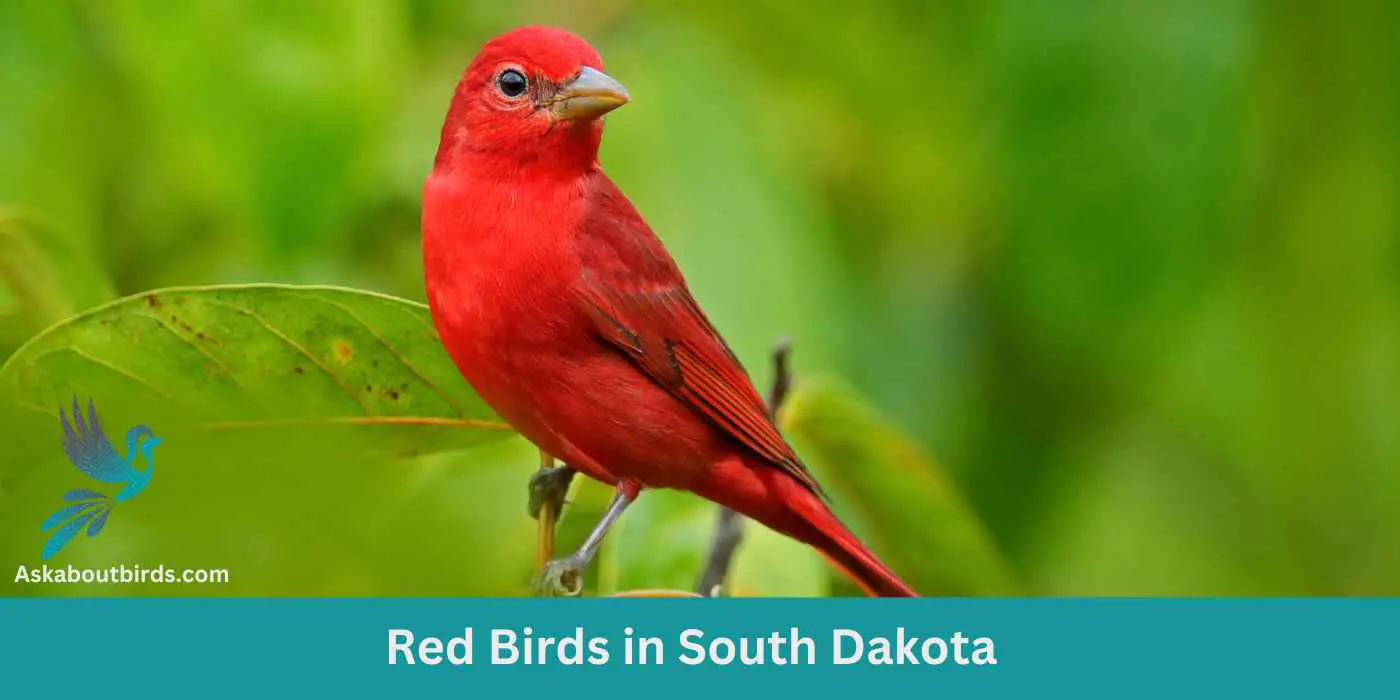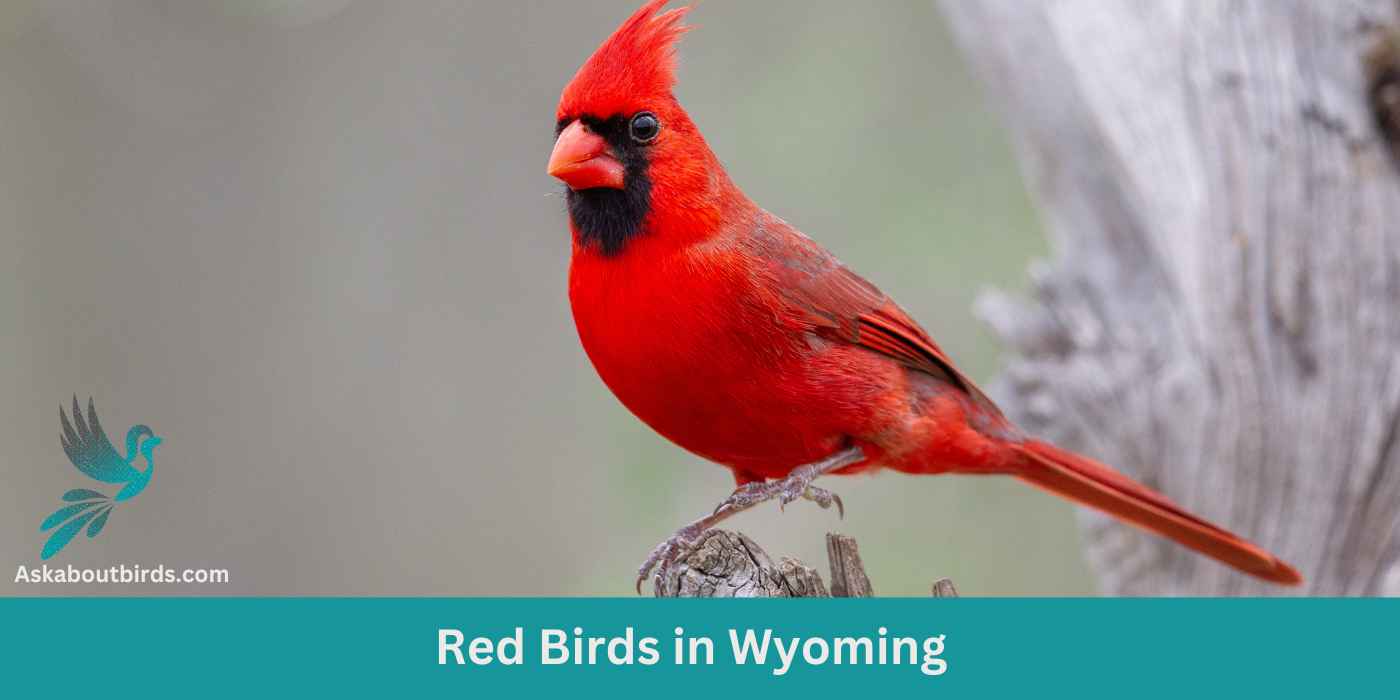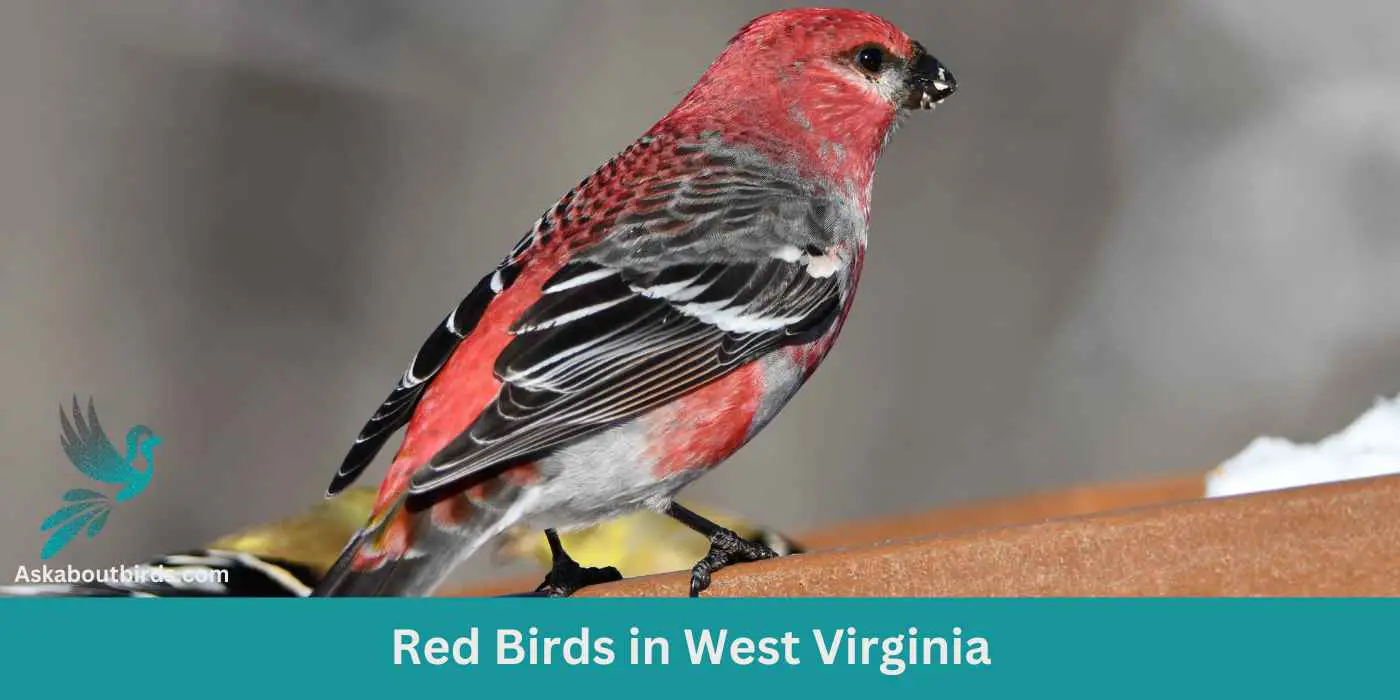South Dakota, with its sprawling prairies and untouched wilderness, is a haven for avian enthusiasts. Among its feathered residents, the state boasts a vibrant tapestry of red birds that capture the imagination.
From the melodic songs of the finches to the dazzling displays of the tanagers, these birds are the gems of South Dakota’s skies.
Dive into our comprehensive guide and discover the 11 red-hued wonders of this Midwestern state. And for those with a penchant for photography, we’ve included a free photo guide to help you capture their captivating beauty.
Red Birds Found In South Dakota
South Dakota’s unique geographical position at the convergence of the Midwest’s grasslands and the West’s rugged terrains creates an intricate mosaic of habitats.
From the wetlands of the east, teeming with waterfowl, to the western pine forests echoing with the calls of mountain species, the state is a crossroads of avian migration and settlement.
This blend of ecosystems, coupled with the changing seasons and rich flora, offers a variety of food sources, nesting sites, and shelter, making South Dakota a treasure trove for diverse bird species, including the captivating red-hued varieties.
Northern Cardinal


| Feature | Measurement |
|---|---|
| Scientific Name | Cardinalis cardinalis |
| Length | 8.3 – 9.1 in |
| Wingspan | 9.8 – 12.2 in |
| Weight | 1.19 – 2.29 oz |
The Northern Cardinal is an iconic North American bird, easily recognized by its vibrant color and melodious song.
Appearance: Male Northern Cardinals are a brilliant scarlet red, while females display a more subdued reddish olive. Both sexes have a distinctive black ‘mask’ on their face around the bill and a pointed crest on their head. The bird’s beak is robust, cone-shaped, and bright orange in color.
Diet: Northern Cardinals are primarily granivorous, with a diet largely consisting of seeds and grains. They also eat fruits and insects. These birds typically feed off the ground and are frequent visitors to bird feeders.
Reproduction: Northern Cardinals are monogamous, and a pair will breed together for life. The female typically builds a well-hidden nest in a dense thicket or shrub. She lays 2-5 eggs per clutch, which she incubates for around two weeks.
Summer Tanager


| Feature | Measurement |
|---|---|
| Scientific Name | Piranga rubra |
| Length | 6.7 in |
| Wingspan | 28 to 30 cm |
| Weight | 29 g |
The Summer Tanager is a medium-sized songbird admired for its radiant plumage and melodious song.
Appearance: Male Summer Tanagers are an impressive bright red, while females and juveniles present a softer, yellow-orange color. Both genders have a large, slightly hooked bill and relatively short tail.
Diet: Summer Tanagers primarily feed on insects, including bees and wasps, which they catch in flight or pick off vegetation. They are also known to eat fruits and berries, making them helpful in controlling pest populations and seed dispersal.
Reproduction: The female Summer Tanager builds a loose, shallow cup-shaped nest out of twigs and grass, usually hidden in the foliage of trees. The female typically lays 3-5 eggs, which she will incubate for about two weeks.
Scarlet Tanager


| Feature | Measurement |
|---|---|
| Scientific Name | Piranga olivacea |
| Length | 6.3 to 7.5 in |
| Wingspan | 9.8 to 11.8 in |
| Weight | 23.5 to 38 g |
The Scarlet Tanager is a strikingly colorful bird known for its brilliant plumage and distinctive song.
Appearance: Male Scarlet Tanagers are notable for their vibrant scarlet bodies contrasted with black wings and tail, making them one of the most intensely colored birds. Females and juveniles, on the other hand, have a subdued olive-yellow body color with darker wings and tail.
Diet: The diet of the Scarlet Tanager is largely made up of insects, including beetles, cicadas, aphids, and others. They are adept flycatchers, seizing insects in mid-air or picking them off foliage. They also consume fruits and berries, especially during migration and in their winter habitats.
Reproduction: The female Scarlet Tanager builds a cup-shaped nest using twigs, rootlets, and grass, typically well-hidden in the dense foliage of trees. She lays 3 to 5 eggs and incubates them for about two weeks.
Western Tanager

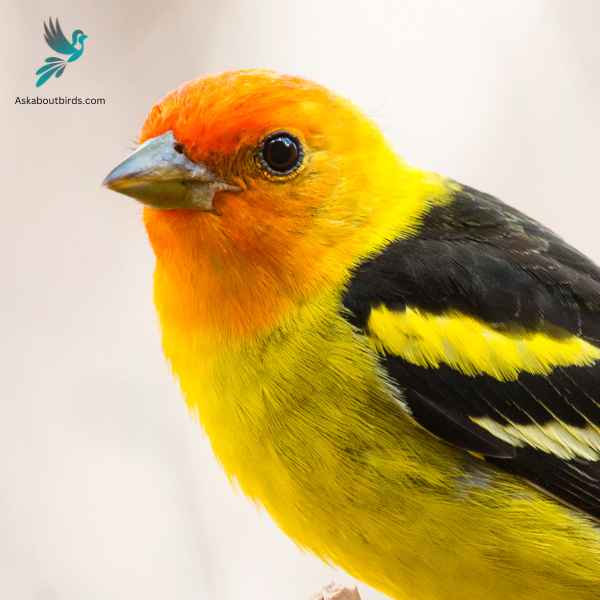
| Feature | Measurement |
|---|---|
| Scientific Name | Piranga ludoviciana |
| Length | 6.3-7.5 in |
| Wingspan | 11.5 in |
| Weight | 24-36 g |
The Western Tanager is a vibrant songbird that graces the forests and woodlands of the western regions of North America, enchanting observers with its colorful plumage and melodious song.
Appearance: The male Western Tanager is renowned for its bright yellow body contrasted with a striking red head and black wings and tail. The females are more subdued in hue, primarily being yellow with grayish wings and back, and lacking the brilliant red head of the males.
Diet: Western Tanagers primarily feed on insects, especially when breeding, but they also incorporate a significant amount of fruits and berries into their diet, especially during migration and winter.
Reproduction: Western Tanagers build their nests high in coniferous trees, often well concealed from potential predators. The female usually lays a clutch of 3 to 5 eggs and takes the primary role in incubation, while both parents are involved in feeding the chicks after they hatch.
Red-Winged Blackbird
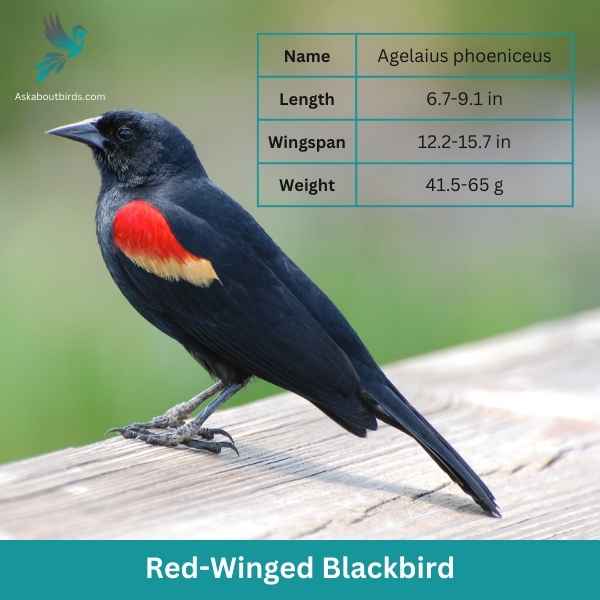
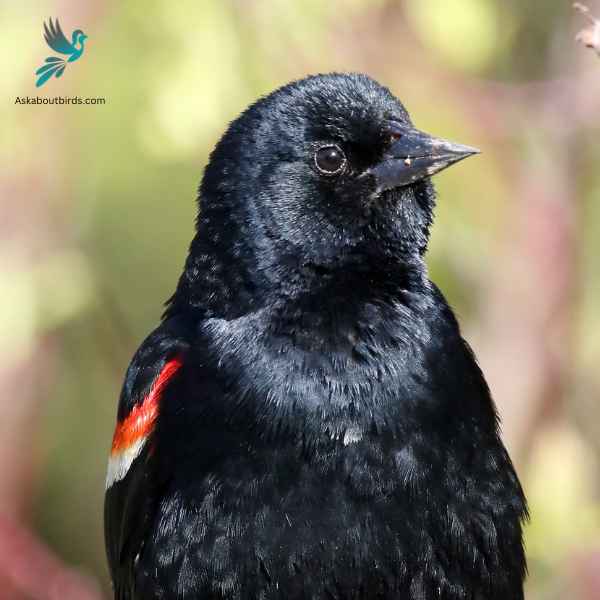
| Feature | Measurement |
|---|---|
| Scientific Name | Agelaius phoeniceus |
| Length | 6.7-9.1 in |
| Wingspan | 12.2-15.7 in |
| Weight | 41.5-65 g |
The Red-Winged Blackbird is a familiar sight across North America, especially in wetlands and open areas. Known for its striking coloration and distinct call, it is often seen perched on cattails or utility lines.
Appearance: Male Red-Winged Blackbirds are glossy black with bright red-and-yellow shoulder patches, while females are streaky brown, resembling a large sparrow. The males’ red patches become more prominent when they’re displaying or agitated.
Diet: Red-Winged Blackbirds primarily feed on seeds and insects. Their diet includes grains, sunflower seeds, and corn, but they also eat beetles, caterpillars, and other small invertebrates, especially in the breeding season.
Reproduction: Red-Winged Blackbirds nest in marshes, along watercourses, and in wet fields. The female constructs a cup-shaped nest using grass and sedge, attaching it to plants above water. She typically lays a clutch of 3 to 4 blue-green eggs, which she incubates for about 11-12 days. Males, being polygynous, often have multiple mates during a single breeding season.
Red-headed Woodpecker

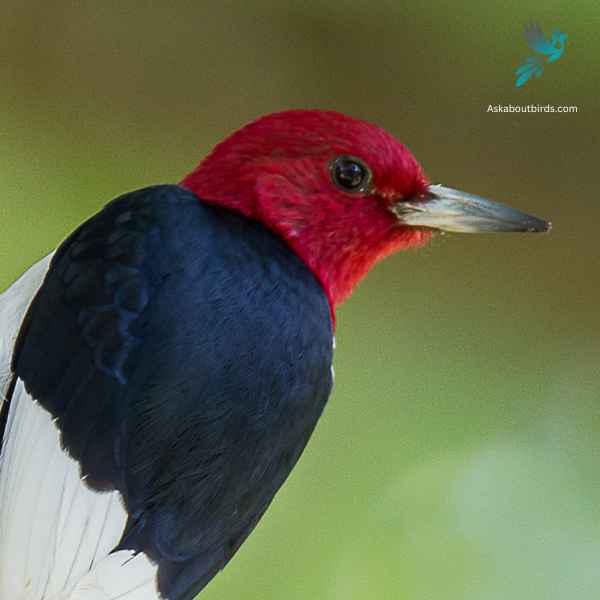
| Feature | Measurement |
|---|---|
| Scientific Name | Melanerpes erythrocephalus |
| Length | 7.5–9.1 in |
| Wingspan | 16.5 in |
| Weight | 2.0–3.2 oz |
The Red-headed Woodpecker is a striking forest bird with a bold tri-colored pattern.
Appearance: This woodpecker features a completely red head and neck, contrasting starkly with its white underparts and black wings. Its wings also have large white patches which are conspicuous in flight.
Diet: Red-headed Woodpeckers have a varied diet including insects, seeds, fruits, berries, and occasionally even the eggs of other birds. They’re also known to store food by wedging it into crevices in bark.
Reproduction: These woodpeckers nest in cavities which they excavate in dead wood or dead parts of live trees. These cavities can be found anywhere from 2 to 80 feet off the ground.
Vermilion Flycatcher
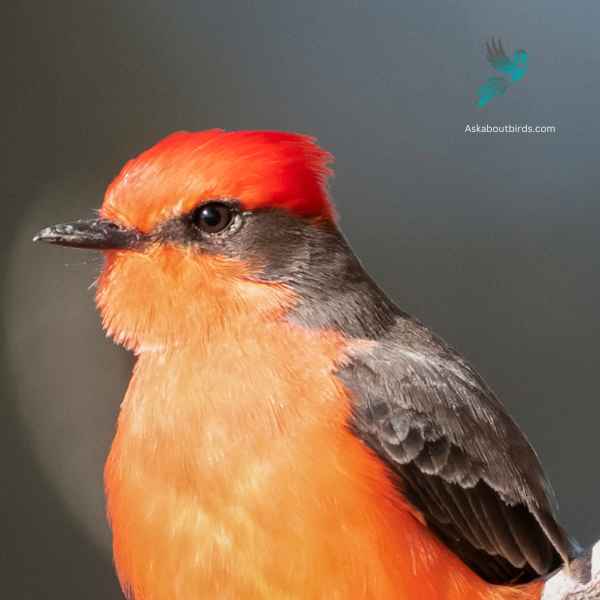

| Feature | Measurement |
|---|---|
| Scientific Name | Pyrocephalus obscurus |
| Length | 5.1–5.5 in |
| Wingspan | 9.4 to 9.8 in |
| Weight | 11 to 14 g |
The Vermilion Flycatcher is a small and colorful bird native to the Americas. The male Vermilion Flycatcher is a striking sight, displaying a vibrant red plumage on its head, breast, and underparts, contrasting with its brown wings and black tail below. Females, on the other hand, have more muted colors, featuring a pale yellowish belly and grayish-brown upperparts.
Vermilion Flycatchers are known for their lively and acrobatic flight displays, which they perform during courtship or to defend their territories. They often sing a series of soft, whistled notes while engaged in these aerial displays. They construct cup-shaped nests, usually in shrubs or low trees, where females lay their eggs and raise their young.
House Finch


| Feature | Measurement |
|---|---|
| Scientific Name | Haemorhous mexicanus |
| Length | 5–6 in |
| Wingspan | 8–10 in |
| Weight | 0.6–0.9 oz |
The House Finch is a small songbird widely distributed across North America and is commonly found in urban and suburban areas.
Appearance: Males of this species are brightly colored with crimson faces and throats, which can extend to the chest and back, while their flanks have streaks. The female is streaked brown and lacks the red coloring. Both have a square-tipped tail and a distinctively long, flat-topped bill.
Diet: House Finches primarily eat seeds, grains, and berries. They have a particular fondness for sunflower seeds and can be commonly seen at bird feeders. Occasionally, they will also consume insects, especially during the breeding season.
Reproduction: House Finches are cavity-nesters and might choose ledges, vents, ledges, and other urban settings. They might also utilize trees or shrubs. Their nests can be made of a wide array of materials, from feathers to twigs.
Pine Grosbeak

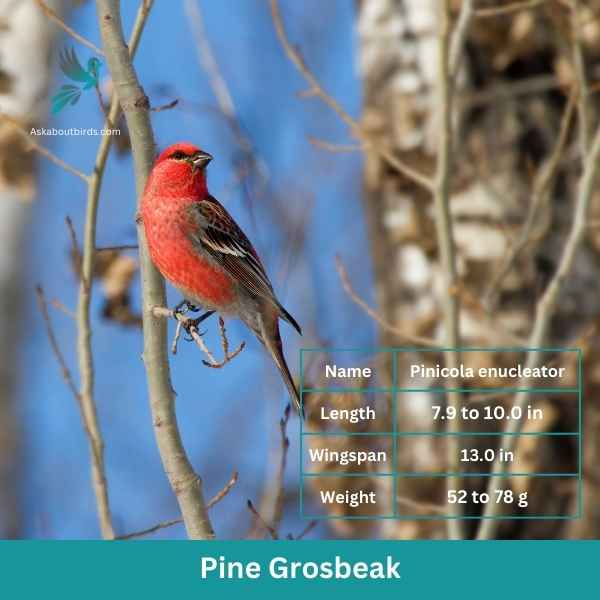
| Feature | Measurement |
|---|---|
| Scientific Name | Pinicola enucleator |
| Length | 7.9 to 10.0 in |
| Wingspan | 13.0 in |
| Weight | 52 to 78 g |
The Pine Grosbeak is a striking bird native to the northern regions of North America, often found in coniferous forests. Both males and females have a plump and robust body with a large beak adapted for eating seeds. The male Pine Grosbeak displays a vibrant reddish-pink plumage, while the female has a more subdued grayish-brown coloration.
These birds are typically seen in small flocks, foraging for food in trees and on the ground. They have a preference for seeds, particularly those from various conifer species. The Pine Grosbeak uses its strong bill to crack open the cones of tall trees and extract the seeds, but they also consume berries and small fruits when available.
Common Redpoll

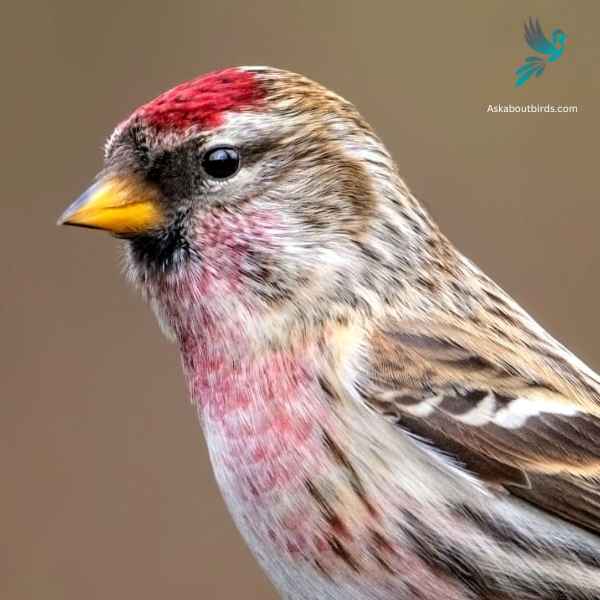
| Feature | Measurement |
|---|---|
| Scientific Name | Acanthis flammea |
| Length | 5.0-5.5 in |
| Wingspan | 7.5-8.5 in |
| Weight | 0.4-0.9 oz |
The Common Redpoll is a small songbird that is easily identifiable by its rosy-red forehead, black chin, and often fluttering flight pattern.
Appearance: Common Redpolls exhibit a distinctive rosy-red forehead patch and black chin. The males typically have a more extensive pink wash on their chest and face than females. The rest of their body is primarily streaked brown and white, with two white wing bars and a notched tail.
Diet: The diet of the Common Redpoll predominantly consists of seeds, particularly from birches and alders. They have a specialized throat pouch where they can temporarily store seeds, allowing them to consume them later in a more sheltered location.
Reproduction: Common Redpolls nest in shrubs or on the ground, using grasses, twigs, and feathers for construction. The female is responsible for the majority of the incubation and typically lays a clutch of 4 to 6 eggs. After the eggs hatch, both parents take part in feeding the young.
Purple Finch


| Feature | Measurement |
|---|---|
| Scientific Name | Haemorhous purpureus |
| Length | 4.7–6.3 in |
| Wingspan | 4.7–6.3 in |
| Weight | 0.6–1.1 oz |
The Purple Finch is a vibrant songbird often mistaken for its close relative, the House Finch, but it exhibits a different hue and patterns.
Appearance: Males are raspberry red on the head, throat, and breast, with streaky brown backs and wings. The intensity of the red can vary among individuals. Females are brown and streaked all over but might show a slight blush on the face. They lack the strong facial patterns seen in female House Finches.
Diet: Purple Finches primarily consume seeds, with a preference for sunflower seeds, dandelion seeds, and buds. They also eat insects and berries, especially during the breeding season.
Reproduction: These finches often nest in conifers or mixed woodlands. The nest, typically located on a horizontal branch, is made from twigs and grass, then lined with feathers.
Where to Spot South Dakota’s Red Birds
South Dakota’s varied terrains are a haven for birdwatchers, with certain spots offering a birding experience like no other. Here are some of the state’s prime locations to witness its avian wonders, especially the vibrant red species:
- Custer State Park: Nestled in the Black Hills, this park offers dense forests, open grasslands, and pristine lakes, attracting a wide range of bird species. It’s especially known for woodpeckers, warblers, and flycatchers.
- Badlands National Park: A striking landscape of rugged badlands, this national park is a hotspot for raptors and prairie species. The colorful rock formations often serve as a backdrop for spotting vibrant birds.
- Bear Butte State Park: Located near Sturgis, this sacred mountain attracts migrating and nesting birds alike. Its mix of grasslands and small lakes offers a diverse habitat for a plethora of species.
- LaCreek National Wildlife Refuge: Situated in the prairie pothole region, this refuge is a vital spot for migratory waterfowl. The wetlands and grasslands also house many songbirds, making it a melodious birding destination.
- Big Sioux Recreation Area: Located near Brandon, its riparian habitat along the Big Sioux River is a magnet for various bird species. Spring and fall migrations bring an influx of diversity, making it a must-visit during these seasons.
| State’s Red Birds | Best Spots for Red Birds |
|---|---|
| North Dakota’s Red birds | 1. Theodore Roosevelt National Park 2. Lostwood National Wildlife Refuge 3. Chase Lake National Wildlife Refuge |
| Nebraska’s Red birds | 1. Crescent Lake National Wildlife Refuge 2. Rowes Sanctuary 3. Fontenelle Forest |
| Wyoming’s Red birds | 1. Yellowstone National Park 2. Seedskadee National Wildlife Refuge 3. Bighorn National Forest |
| Montana’s Red birds | 1. Glacier National Park 2. Charles M. Russell National Wildlife Refuge 3. Lee Metcalf National Wildlife Refuge |
| Minnesota’s Red birds | 1. Superior National Forest 2. Agassiz National Wildlife Refuge 3. Sherburne National Wildlife Refuge |
| Iowa’s Red birds | 1. Neal Smith National Wildlife Refuge 2. Ledges State Park 3. Effigy Mounds National Monument |
FAQs on Red Bird Species Found in South Dakota
Why are black oil sunflower seeds favored by bright red birds in Black Hills National Forest?
In Black Hills National Forest, bright red birds such as the male northern cardinal with its striking red plumage often visit bird feeders stocked with black oil sunflower seeds. The region, with its dense forest canopy and edges, provides the ideal habitat for these birds. These seeds are rich in nutrients and are a favorite among other bird species too, especially those with greyish white wings or bright yellow-green colorations.
Do white winged crossbills in Central and South America consume black oil sunflower seeds?
White winged crossbills, characterized by their rosy pink head and tail feathers, primarily feed on conifer seeds in their native habitats, especially pine cones. While these birds are more common in the northern and western states, they are rare in Central and South America. Should they visit bird feeders in these regions, black oil sunflower seeds might appeal to them, though they’re not a staple in their diet.
How do painted buntings from Central America respond to black oil sunflower seeds?
The painted bunting, particularly male birds with their dazzling bright blue heads and green wings, might show interest in black oil sunflower seeds if they visit backyard feeders in regions outside their typical habitat. While they primarily hail from Central America and the southern and eastern states, painted buntings with their distinctive bright red and green plumage could be enticed by these seeds, enriching the bird diversity in any backyard.
Are black oil sunflower seeds common in feeders across eastern and southern states for red birds?
Yes, across the eastern and southern states, black oil sunflower seeds are a popular choice in backyard feeders, especially for birds with bright red plumage. Birds like the red crossbill with its red body and distinct gray wings are particularly fond of these seeds. Given their high nutritional content, these seeds serve as an essential food source for various medium-sized bird species, whether they have a red crown, white throat, or even a dark line across their eyes.

